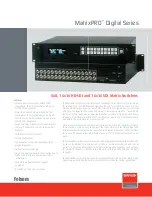
150
C
HAPTER
21: 802.1
X
C
ONFIGURATION
PAE
A PAE (port access entity) is responsible for the implementation of algorithm and
protocol-related operations in the authentication mechanism.
The authenticator system PAE authenticates the supplicant systems when they log
into the LAN and controls the authorizing state (on/off) of the controlled ports
according to the authentication result.
The supplicant system PAE responds to the authentication requests received from the
authenticator system and submits user authentication information to the
authenticator system. It can also send authentication and disconnection requests to
the authenticator system PAE.
Controlled port and uncontrolled port
The Authenticator system provides ports for supplicant systems to access a LAN. A
port of this kind is divided into a controlled port and an uncontrolled port.
■
The uncontrolled port can always send and receive packets. It mainly serves to
forward EAPoL packets to ensure that a supplicant system can send and receive
authentication requests.
■
The controlled port can be used to pass service packets when it is in authorized
state. It is blocked when not in authorized state. In this case, no packets can pass
through it.
■
Controlled port and uncontrolled port are two properties of a access port. Packets
reaching an access port are visible to both the controlled port and uncontrolled
port of the access port.
The valid direction of a controlled port
When a controlled port is in unauthorized state, you can configure it to be a
unidirectional port, which sends packets to supplicant systems only.
By default, a controlled port is a unidirectional port.
IV. The way a port is controlled
A port of a S4200G series switch can be controlled in the following two ways.
■
Port-based authentication. When a port is controlled in this way, all the supplicant
systems connected to the port can access the network without being
authenticated after one supplicant system among them passes the authentication.
And when the authenticated supplicant system goes offline, the others are denied
as well.
■
MAC address-based authentication. All supplicant systems connected to a port
have to be authenticated individually in order to access the network. And when a
supplicant system goes offline, the others are not affected.
The Mechanism of an
802.1x Authentication
System
IEEE 802.1x authentication system uses extensible authentication protocol (EAP) to
exchange information between the supplicant system and the authentication server.
Figure 44
The mechanism of an 802.1x authentication system
Supplicant system
PAE
Authenticator
System PAE
Authentication server
EAPoL
EAP/PAP/CHAP exchanges
carried by RADIUS protocol
Supplicant system
PAE
Authenticator
System PAE
Authentication server
EAP/PAP/CHAP exchanges
carried by RADIUS protocol
Supplicant system
PAE
Authenticator
System PAE
Authentication server
EAPoL
EAP/PAP/CHAP exchanges
carried by RADIUS protocol
Supplicant system
PAE
Authenticator
System PAE
Authentication server
EAP/PAP/CHAP exchanges
carried by RADIUS protocol
Summary of Contents for 3CR17660-91
Page 10: ...8 CONTENTS ...
Page 14: ...4 ABOUT THIS GUIDE ...
Page 46: ...32 CHAPTER 5 LOGGING IN THROUGH WEB BASED NETWORK MANAGEMENT SYSTEM ...
Page 48: ...34 CHAPTER 6 LOGGING IN THROUGH NMS ...
Page 60: ...46 CHAPTER 9 VLAN CONFIGURATION ...
Page 64: ...50 CHAPTER 10 MANAGEMENT VLAN CONFIGURATION ...
Page 80: ...66 CHAPTER 13 GVRP CONFIGURATION ...
Page 98: ...84 CHAPTER 15 LINK AGGREGATION CONFIGURATION ...
Page 112: ...98 CHAPTER 18 MAC ADDRESS TABLE MANAGEMENT ...
Page 126: ...112 CHAPTER 19 LOGGING IN THROUGH TELNET ...
Page 162: ...148 CHAPTER 20 MSTP CONFIGURATION ...
Page 274: ...260 CHAPTER 29 IGMP SNOOPING CONFIGURATION ...
Page 276: ...262 CHAPTER 30 ROUTING PORT JOIN TO MULTICAST GROUP CONFIGURATION ...
Page 298: ...284 CHAPTER 33 SNMP CONFIGURATION ...
Page 304: ...290 CHAPTER 34 RMON CONFIGURATION ...
Page 338: ...324 CHAPTER 36 SSH TERMINAL SERVICES ...
Page 356: ...342 CHAPTER 38 FTP AND TFTP CONFIGURATION ...
Page 365: ...Information Center Configuration Example 351 S4200G terminal logging ...
Page 366: ...352 CHAPTER 39 INFORMATION CENTER ...
Page 378: ...364 CHAPTER 40 BOOTROM AND HOST SOFTWARE LOADING ...
Page 384: ...370 CHAPTER 41 Basic System Configuration and Debugging ...
Page 388: ...374 CHAPTER 43 NETWORK CONNECTIVITY TEST ...
Page 406: ...392 CHAPTER 45 CONFIGURATION OF NEWLY ADDED CLUSTER FUNCTIONS ...
















































